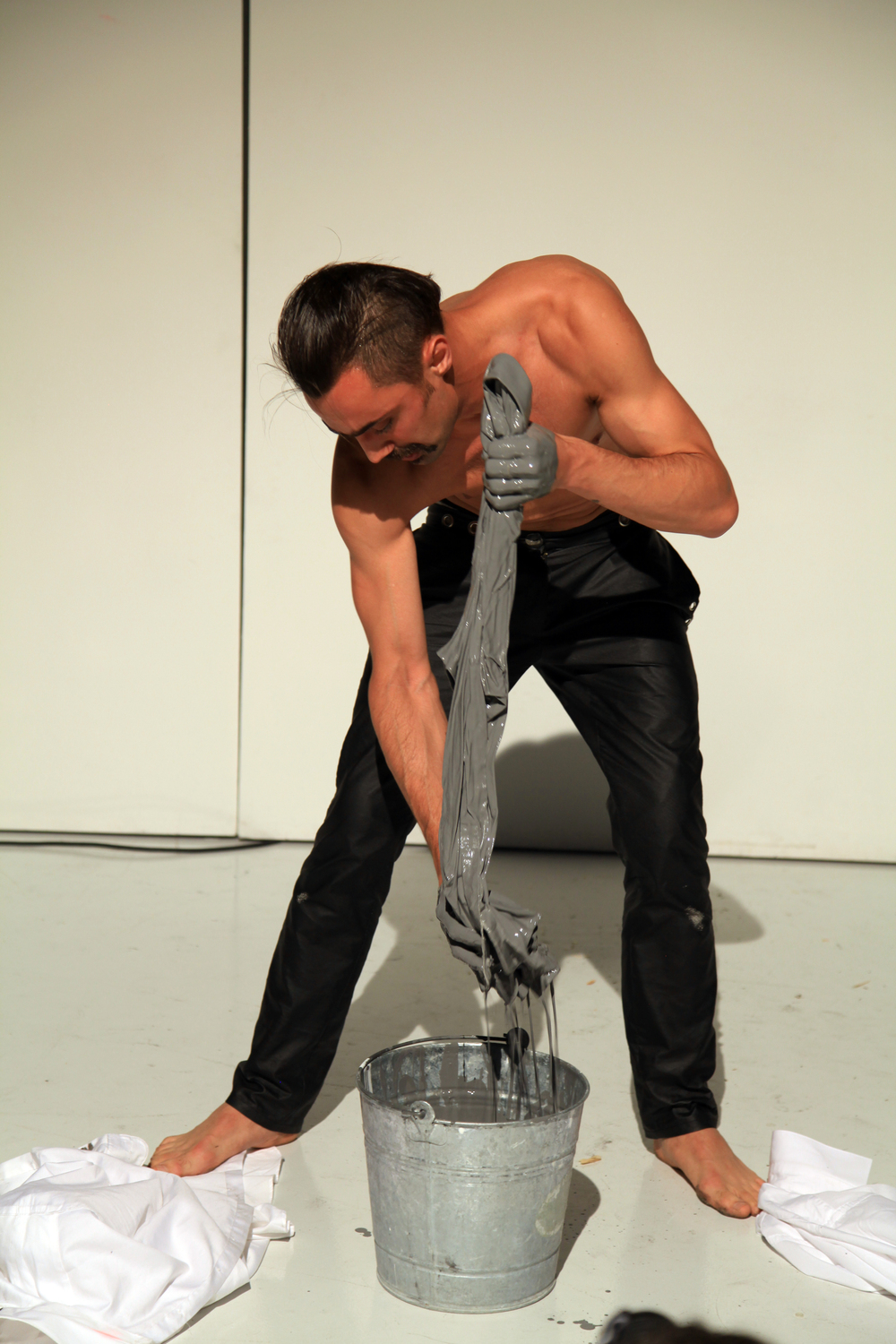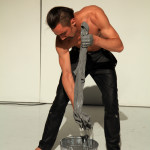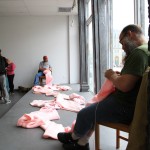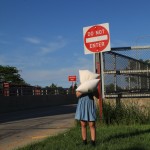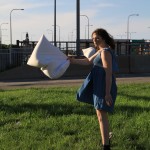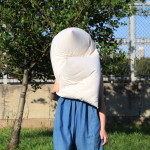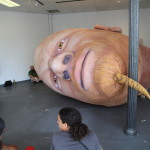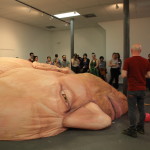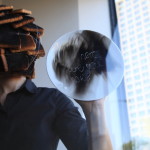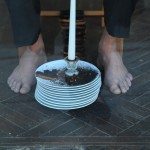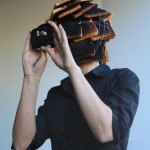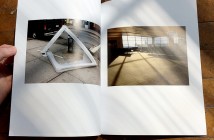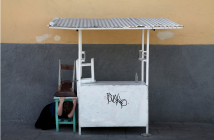In its second year, Rapid Pulse aimed to represent multiple styles and forms of performance art as a way to provoke thought and stimulate discourse. Throughout the ten-day festival, Rapid Pulse offered artist talks and panel discussions in the early afternoons, durational works in the late afternoons, featured one to three pieces each evening, and a video program compiled of documentation of performance works and performances made for the screen. Each video program was curated around a theme including "Erotic/Autoerotic," "Facing the Lens," "Corporeal Discomforts," "Public Infringements," and "Spatial Body." Panel discussions tackled performance related topics such as "SKIN: Liminal Boundaries," "Performance and Pedagogy," ‘Transformations," and more. These discussions illuminated different artistic processes, relationships to duration, ritual, collaboration, and unpredictability. Throughout the festival, Rapid Pulse expanded its audience through the inclusion of a Festival Blog and a Livestream of select performances. The festival activated several spaces around Wicker Park including Defibrillator Performance Art Gallery, The Electrodes (Defibrillator’s Store Front Windows), a temporary space labeled the Hub, outdoor spaces in the neighborhood, and the Nightingale Theatre. The festival kicked off with a vernissage that featured a talk from participating artist, Wafaa Bilal.
Experiences Unique to the Twenty-First Century
Well-known for implanting a camera into his head, and the interactive 31 day performance titled Domestic Tension, aka "Shoot an Iraqi," Bilal serves an excellent example of an artist working with the post-human body. Living as an Iraqi in America, Bilal learned that his brother was killed by a missile in their hometown of Kufa in 2004. Deeply impacted by this experience, Bilal began creating work that employs interactive internet-based technologies to teach empathy and inspire a deeper level of awareness of one’s actions. Days after Bilal delivered his artist talk, his piece, #TECHNOVIKING filled (literally) Rapid Pulse’s Hub. The piece addressed the life and death of internet memes, using the once viral Technoviking as inspiration. This captioned video features a man dancing through the streets, shirtless and donning a Viking-esque hairstyle and beard. Contemplating where memes disappear to and the pace of their obsolescence, Bilal piece consisted of a large inflatable of the Technoviking’s head was re-inflated in public space. When people tweeted #Technoviking the sculpture was given a 20 second burst of air. Over the duration of several hours, the Technoviking went through various stages of re-inflation, relying on the platform of the internet for its reinvention. The piece illuminated how technology has expanded the human reach and the potential of collective action.
This notion of collective action was continued through Brooklyn-artist, Kambui Olujimi’s, A Life in Pictures. For two days, people were invited to bring pictures from their lives to exchange with pictures from Olujimi’s life. The images, consequently mixing together, became a document not of one individual’s life, but of collective existence. Current technology has resulted in an excessive level of documentation. With cameras and social media at our fingertips, we are constantly armed with devices that capture and share experiences in an instant. The piece brought the sensation of touch back into the equation, Olujimi insisting that the photographs be physical. The installation included an area where participants could email photos and have them instantly printed. For many (myself included), this provided the opportunity to see important images printed and experienced away from the interface for the first time.
Berlin-based artist, Allison Halter also explored the Internet as a research tool unique to the twenty-first century. In her lecture style performance R. KELLY: A Critical Appreciation, Halter delivered a critical analysis of R. Kelly’s work, reframing his music and videos through the language of ‘art-speak.’ Her piece illuminated the absurdity of this language and offered an opportunity for the audience to consider the boundaries and potential created by language and context. For those who did not experience the piece live, R. KELLY: A Critical Appreciation could easily be dismissed as pure parody, however, Halter expressed genuine affection for this R&B star. By sharing her love of this celebrity in her own language, Halter offered an opportunity to contemplate how technology has evolved to build seemingly unlikely, yet significant connections.
Performance and Nationalism
International performance art festivals sometimes remind me of the Olympics. Artists often work from an impulse to show pride in the places they come from, simultaneously using the context of these festivals to critique the histories and current social climates of their homelands. Arguably, all of the participating artists explored place in this way to some extent, but Italian artist Francessca Fini and Polish artist Arti Grabowski were most notable. Both artists created pieces steeped in references to their countries, yet their actions had a deep connection to the basic human experience, making the work accessible to a wider audience. In her piece titled Fair & Lost, Fini attached an EMS machine to her upper arm as she spoke about and demonstrated actions that are connected to her experience being Italian and female. The electrodes caused reflexes in her arms that distorted her movements in ways that were both disturbing and humorous. As Fini covered her face in makeup, eyeliner scrawling across her face, every person in the room who had ever accidently poked themselves in the eye with a mascara wand empathized with her. Because we were united, this gave an entry point into the piece that allowed the audience to deconstruct the work with a deeper level of critical thinking. Grabowski used actions that were rooted in images that alluded to histories of Polish conflict and cultural iconography. Using references to Polish Olympian, Adam Małysz, known for his ski-jumping career, Grabowski’s piece explored themes of heroism mixed with the shared desire for human flight. Grabowski used humor and created actions that produced strong smells that resulted in the audience oscillating between induced coughing and laughter. This collective physical response created a visceral and shared experience for those who witnessed the piece.
Days before Rapid Pulse began, protests erupted in Turkey after a peaceful demonstration to protect the last green space in Istanbul’s main commercial district turned violent. Turkish artist, Sükran Moral created a performance that began with a letter read by the Festival’s Director, Joseph Raven. The letter explains that the piece entitled, The Lynching of an Artist was conceived before the civil unrest broke out in her homeland, but that the reasons behind creating the piece were also in response to the government’s position against secular democracy and its insistence on oppressive policies. The letter dedicated the performance to those putting their lives at risk in public protest and asked for participation from the Rapid Pulse audience. In the letter, Moral identified a cue within the piece, after which she wanted the audience to spit on her. This created tension in the room, those wishing to respect the artist’s wishes, others refusing to engage in an action of disrespect. This request was rooted in representation alone. By regurgitating the same behavior of the very thing that she was critiquing felt unproductive. Being asked to comply at the beginning of the piece through the emotion and sincerity of the letter, made the interaction feel like more of an obligation rather than a choice. At the end of the evening it left the audience split between those who had spit and those who hadn’t. Those who chose to spit, explaining that they only did so because they (in most cases artists themselves) wanted to respect the artist’s wishes.
In contrast, Andrew Barco’s Pale Blue Eyes ignited audience interaction in an unexpected way. Upon entering Defibrillator Gallery, each spectator was given a pink dust mask and directed to their "seat." In most cases this meant a spot to stand, sometimes on top of a bench. The space had been arranged in such a way that divided the audience. Some people were positioned to focus on the Chicago-based artist diligently picking at a translucent cube with surgical tools on top of a light table. On the other side of the room, the audience was focused on a small radio that gave directives to the audience based on probability. Splitting the audience physically and utilizing so many objects made the performance feel both absurd and confusing. I struggled to find connections between all of the materials that were simultaneously being activated. In the final actions of the piece, Barco introduced a series of objects, holding each one up as he asked the question, "Why are we still doing this?" He circled the space so that everyone could see his collection of objects. He described each object:
A "wee can" of Vienna sausage,
a bottle of pills for a "liver" cleanse,
an empty film "reel,"
a beaker containing blue liquid "solution,"
a clock set to the "hour four",
and a piece of bread, called "pain" in French.
Barco begins to repeat, cycling through his collection of objects, each time dropping some words. This continues until he begins to recite "We can deliver real solutions for our pain." These last moments of the performance, illuminated that the initial confusion was intentional choice to support the piece’s content. The confusion also created a myth around the piece that continued to evolve throughout the remainder of the festival. Witnesses had to talk about the ambiguity of the performance with one another to make sense of it. Although the piece did not seem to be making an overt political statement in the moment, it made use of the context of an international event to inspire dialogues around the current political climate of the United States and alternative navigations within a capitalist society.
The Power of Two
Rapid Pulse included a large number of collaborative duos, something that Chicago’s performance art scene is increasingly becoming known for. As an artist who has been working with the same collaborator for nine years, I am always interested in experiencing different approaches to collaboration. Interestingly, all of the collaborative duos in the festival created durational pieces. Perhaps, allowing a piece to unfold over an extended period of time lends itself well to balancing the goals and processes of two artists.
Chicago-based artist couple, Miller and Shellabarger created a piece that has been active for ten years. The two bearded men sat at opposite ends of the storefront window of Rapid Pulse’s Hub where they spent four hours collaboratively crocheting a pink tube that they have been creating together since 2003. The performance created a mundane image, requiring little analysis on behalf of the audience, however, the sincerity of their demeanor and commitment to this action was easily understood and profoundly moving. Miller and Shellabarger engaged the audience in casual conversation as they crocheted. The audience discovers that they learned to crochet from a friend, the action is always made in public space, and the last time they measured the tube it was about 70 feet in length. We learned that the piece will continue until one of the men can no longer crochet. Most likely, this will occur at death. When this happens, the other has agreed to unravel the tube. The piece oscillated between tenderness and straightforwardness around the impossibility of forever. In a culture that sensationalizes, sanitizes, and excessively fears death, Miller and Shellabarger’s acceptance of mortality was refreshing.
Chicago’s Mothergirl (Sophia Hamilton and Katy Albert) also used a public context and repeated act in their piece, Don't Sleep There's a War Going On. Positioned on a patch of grass next to the I-90/I-94 on ramp, the two artists repeatedly hit themselves in the face with a pillow. They engaged in this solo pillow fight for nearly two hours. Both artists wore identical blue dresses, boots, and focused gazes as commuters passed by. Albert methodically used one arm to hit herself, while Hamilton used two hands, subsequently marking her face with large red patches. Hamilton was positioned closer to the ramp, making her subject to more catcalls. One driver yelled from their car window "Do you need some medication?!" The piece addressed how culture influences how actions are read on certain bodies. If Miller and Shellabarger and Mothergirl had switched places would the driver had made the assumption that Hamilton was suffering from some mental illness? The piece also led me to imagine what kinds of reactions that Miller and Shellabarger have received over the past decade, engaging in an action widely perceived as "feminine."
Another art couple, UK-based Zierle and Carter activated The Electrodes and Defibrillator Gallery over the duration of several hours on two consecutive days. On the first day of AT the EDGE of LONGING: Charred Territories, they performed exclusively in the windows. They created a dream like experience in which they wrote messages to one another. Their heads were covered in black toast that was attached with precariously wrapped filament. This resulted in the artists creating each action with a careful and slow pace, making the piece meditative to watch. Using the flame of a candle, they blackened the surface of plates and wrote messages into the soot. While Carter blackened the silver on a butter knife, Zierle scraped a hole into a piece of toast that had fallen from her head, creating a portal, perhaps for communication. As the performance unfolded, reflections from the sun and nearby buildings imposed themselves on the windows. At certain points this made the two figures disappear, an unplanned yet powerful addition to the work.
Time as Material
Performance art makes use of real time and space as material. This creates a potential for the work to create alternate perceptions of reality as it constructs and deconstructs time. In addition to many of the durational works described previously, several other artists presented different strategies for utilizing extended durations. Some relied on the thresholds of the body like Italian artist Arianna Ferrari in her piece, H-Transmitter. Other artists used chemicals to control their body’s own conception of time. Berlin-based artist Elana Katz used sleeping pills to ensure that her body could withstand 8 hours of sleep while being misted with water in her piece, They Said it Was Dry. Over the duration of 4 hours, Carlos Salazar Lermont also engaged in a chemical induced sleep in his piece Ecce Homo. His body was vulnerably positioned next to an open can of Gasoline and a box of matches. The Venezuelan artist not only controlled the duration that his body would endure, but also controlled the duration in which the piece would be witnessed. The gasoline provided too strong of a smell for most individuals to bear for more than a few minutes. Other artists used materials to lead them through real-time in their work like Anna Berndston (Sweden Germany) who churned cream into butter using her body for more than 4 hours. Yet another Chicago-based artist couple, Rooms, created a structure reliant on chance to challenge perceptions of time in their delegated performance, Meaning Machines. Seven actors/actresses dressed in white and wearing white-eye masks contoured to their faces, were plugged into earphones that randomly shuffled through a series of cues. Through sensory deprivation and the repetitive actions, the performers appeared to transcend time and space, taking the audience with them.
In Closing
Rapid Pulse was successful in achieving its goal to produce a diverse and thought-provoking festival. The work was well curated and each day was carefully programmed to prevent festival fatigue, a common result of performance art festivals that show 10-20 live pieces per day. This choice along with the presence of the livestream and writing on the festival’s blog provided participating artists and the audience time and space for deeper contemplation of the work that was presented. The blog and livestream, however, are not stand-ins for witnessing work live. One of the most important pieces of knowledge that I was taught by my instructors that I now pass down to my own students is that, "you miss it if you don’t show up." Live art cannot be experienced through a photograph, through a video, or through the written word. One must be present with the work to truly understand the totality and complexities of the piece. The format of the performance art festival may not be the most ideal context for all work, but it does offer a concentrated experience to witness performance-based works. As demonstrated by Rapid Pulse, if produced with a sensitive approach, it can offer a fruitful environment for artists and spectators to further develop ideas and dialogues around the past, present, and future of experiential art.
- Arti Grabowski, 2013. Photo by Sandrine Schaefer
- Miller and Shellabarger Untitled, 2013. Photo by Sandrine Schaefer
- Mothergirl Don’t Sleep, There’s a War Going On, 2013.Photo by Sandrine Schaefer
- Mothergirl Don’t Sleep, There’s a War Going On, 2013.Photo by Sandrine Schaefer
- Mothergirl Don’t Sleep, There’s a War Going On, 2013.Photo by Sandrine Schaefer
- Wafaa Bilal TECHNOVIKING, 2013. Photo by Sandrine Schaefer
- Wafaa Bilal TECHNOVIKING, 2013. Photo by Sandrine Schaefer
- Zierle & Carter AT the EDGE of LONGING: Charred Territories, 2013. Photo by Sandrine Schaefer
- Zierle & Carter AT the EDGE of LONGING: Charred Territories, 2013. Photo by Sandrine Schaefer
- Zierle & Carter AT the EDGE of LONGING: Charred Territories, 2013. Photo by Sandrine Schaefer

